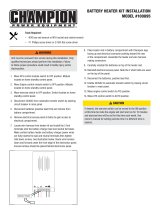TP-6694 9/20 3
Table of Contents
Safety Precautions and Instructions ........................................................................................................................................ 7
Introduction .............................................................................................................................................................................. 13
Service Assistance................................................................................................................................................................... 15
Section 1. Specifications and Features ................................................................................................................. 17
1.1 Introduction ............................................................................................................................................................ 17
1.2 Controller Features................................................................................................................................................. 17
1.2.1 Switches and Controls ............................................................................................................................. 18
1.2.2 Annunciator Lamps .................................................................................................................................. 19
1.2.3 Digital Display .......................................................................................................................................... 21
1.2.4 Controller Fault Diagnostics ..................................................................................................................... 28
1.2.5 Digital Display Circuit Board and Connections ......................................................................................... 30
1.2.6 Main Logic Circuit Board .......................................................................................................................... 31
1.2.7 Terminal Jumper ...................................................................................................................................... 32
1.2.8 Communication Ports ............................................................................................................................... 33
1.2.9 Fuses ....................................................................................................................................................... 33
1.3 Controller Logic Specifications ............................................................................................................................... 34
1.3.1 Status Event and Fault Specifications ...................................................................................................... 35
1.3.2 Voltage Regulator and Calibration Specifications .................................................................................... 41
1.3.3 Voltage Regulator Adjustments................................................................................................................ 41
Section 2. Operation ................................................................................................................................................ 43
2.1 Prestart Checklist ................................................................................................................................................... 43
2.2 Exercising Generator Set ....................................................................................................................................... 44
2.3 Operations in Cold Weather Climates .................................................................................................................... 44
2.4 Controller Operation ............................................................................................................................................... 44
2.4.1 Starting..................................................................................................................................................... 45
2.4.2 Stopping (User Stopping and Fault Shutdown) ........................................................................................ 46
2.4.3 Emergency Stop Switch Resetting ........................................................................................................... 46
2.4.4 System Status Lamps .............................................................................................................................. 46
2.4.5 System Fault Warning Lamp with Digital Displays ................................................................................... 46
2.4.6 System Fault Shutdown Lamp with Digital Displays ................................................................................ 49
2.4.7 Status and Notice Digital Displays ........................................................................................................... 52
2.4.8 Controller Resetting (Following System Shutdown or Warning)............................................................... 54
2.4.9 Powering up the Engine Control Module (ECM) ...................................................................................... 55
2.5 Menu Displays ........................................................................................................................................................ 57
2.6 Monitoring and Programming Setup ....................................................................................................................... 59
2.6.1 PC Communications ................................................................................................................................ 59
2.6.2 Modbus® Communications ...................................................................................................................... 60
2.7 Reviewing Menu Displays ...................................................................................................................................... 60
2.7.1 Error Messages ........................................................................................................................................ 62
2.7.2 Overview .................................................................................................................................................. 63
2.7.3 Engine Metering ....................................................................................................................................... 64
2.7.4 Generator Metering (and Calibration) ...................................................................................................... 64
2.7.5 GenSet Information .................................................................................................................................. 67
2.7.6 GenSet Run Time .................................................................................................................................... 67
2.7.7 GenSet System ........................................................................................................................................ 67
2.7.8 GenSet Calibration ................................................................................................................................... 68
2.7.9 Voltage Regulator .................................................................................................................................... 70
2.7.10 Digital Inputs ............................................................................................................................................ 71




















